1. a) i) State the laws of refraction of light
ii) A small object is placed at a distance of 30.0cm from a converging lens of focal length 10.0cm. Calculate the distance from the first lens where a second converging lens of focal length 40.0cm must be placed in order to produce an erect image of the same size as the object.
b) i) Draw a diagram to show the formation of an image by a compound microscope in normal adjustment and use it to derive an expression for the magnifying power.
ii) A microscope has an objective of focal length 10.0cm an and eye piece of focal length 20.0cm. If the distance between the objective and eye piece is 20.0cm, calculate the magnifying power of the microscope.
c) What is meant by the following :
i) Total internal reflection,
ii) Critical angle
d) Briefly explain why an observer sees a spectrum of colors through rain drops when it is raining on a sunny day.
2. a) i) Derive the relationship for a convex lens, where u is the object distance, v is the image distance and f is the focal length of the lens.
for a convex lens, where u is the object distance, v is the image distance and f is the focal length of the lens.
ii) State three possible reasons under which an image of a real object may not be formed by a convex lens on a screen.
b) Describe an experiment to determine the focal length of a convex lens fixed inside a short cylindrical tube
c) A convex lens of focal length 10cm is arranged coaxially with a concave lens of focal length 18cm. The lens system is used to focus an object placed 24cm from the convex lens on the side remote from the concave lens. The final image is formed on a screen placed 18.6cm from the concave lens.
Calculate the;
i) separation between the lenses
ii) magnification
3. a) Define the following:
i) Transverse waves
ii) Longitudinal waves
b) When a plane wave traverses a medium, the displacement of the particles is given by, y = 0.01 sin 2ᴨ (2t – 0.01x), where y and x are in meters and t in seconds.
Calculate the;
i) frequency of the wave
ii) wave velocity
iii) phase difference at a given instant of time, between two particles 50m apart.
c) Describe an experiment to determine the velocity of sound in air by an interference method.
d) i) Stat two applications of the Doppler effect
ii) Derive an expression for the frequency f , of sound as heard by a stationary observer when the source of sound of frequency f approaches with uniform speed us.
4. a) Explain what is meant by an interference pattern as applied to light waves
b) Explain why it is necessary to use a common source when demonstrating interference in light
c) In an experiment to determine wavelength of light using Young’s method, two slits, at a separation of 1.3mm were used.
When the screen was placed 18.0cm from the slits, 30 bright fringes occupying a distance 2.5mm were obtained.
i) Find the wavelength of the light used
ii) List the changes that would be observed if the distance of the screen from the slits were increased.
d) i) Derive the expression for the angular position of the nth order principal maximum produced by a transmission diffraction grating.
ii) Light of two wavelengths 5.4 x 10-7 m and 5.7 x 10-7 m is incident normally on a transmission grating with spacing 2.00 x 106m. Find the angular separation of the second order principal maxima.
iii) Suppose white light is used in (d) (ii), describe the positions of red and violet lights in the first order principal maximum relative to the central maximum
5.a) i) Write down the expression for the force on a charge, q coulombs moving with velocity, u, at an angle, α, to a uniform magnetic field of flux density B.
ii) Use the expression in (a) (i), to deduce the force on a conductor carrying a current in a magnetic field.
b) Figure 1 shows an aluminum bar AB resting on two horizontal aluminum rails connected to a battery through switch K. A magnetic field of flux density 0.10T, acts perpendicularly into the paper.
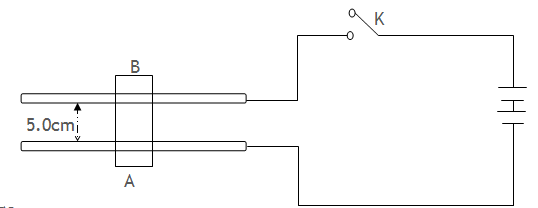
i) Explain what happens to AB when switch K is closed
ii) Calculate the angle to the horizontal to which the rails must be tilted to keep AB stationary if its mass is 5.0g, current in it is 4.0 A and the direction of the field remains unchanged.
c) i) With the aid of a labeled diagram. describe the structure and mode of operation of a moving coil galvanometer
ii) Discuss the factors which affect the current sensitivity of a moving coil galvanometer
6.a) State the laws of electromagnetic induction
b) i) With the aid of a diagram, describe how a simple a.c generator works
ii) What are the main energy losses in a practical a.c generator and how are they minimized?
c) A circular coil having 20 turns each of radius 8.0cm is rotated about its vertical diameter with angular speed of 50 radians per second in a uniform horizontal magnetic field magnitude 30 mT.
i) Calculate the r.m.s value of the e.m.f induced in the coil.
ii) If the coil forms a closed loop of resistance 10 Ω, how much power is dissipated as heat in it?
d) Below is a capacitor and bulb connected a.c supply
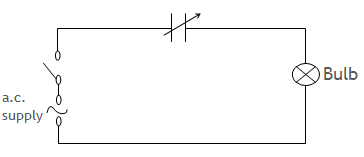
Explain;
i) why the bulb lights when switch K is closed
ii) what would happen if the capacitance were reduced
e) Explain the following observations
i) A spark is seen at the switch when the circuit of a current carrying coil is broken
ii) A magnetized iron bar dropped vertically through a hollow region of a thick cylindrical shell made of copper experiences a retarding force
7.a) Define the following;
i) peak value
ii) root mean square (r.m.s) value f an alternating current
b) Derive an equation relating peak value and r.m.s value of an alternating current
c) An electric current flows through a coil of 4Ω immersed in 200g of water placed in a container. If the temperature of the water rises by 1K per minute, calculate the peak value of current supplied
d) What is meant by resonance in a circuit?
e) A lamp of resistance 10Ω, A capacitor of capacitance 0.4μ F and an inductor of inductance 0.4H are connected in series to an alternating voltage source of 0.01V (r.m.s). The frequency f, is varied from low to high value while maintaining the amplitude of the applied voltage constant.
i) Explain how the brightness of the lamp varies
ii) Calculate the resonant frequency
iii) Find the voltage across the capacitor
f) Explain why in an R-C circuit, power is only absorbed by the resistive part of the circuit
8. a) State Coulomb’s law of electrostatics
b) i) Describe how a conductor may be positively charged but remains at zero potential
ii) Explain how the presence of a neutral conductor near a charged conducting sphere may reduce the potential of the sphere.
c) In figure 3, points P and Q are at distances 30.0cm and 20.0cm from a point charge of 4.0μC, respectively.
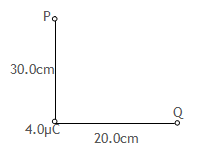
Calculate the;
i) electric potential difference between P and Q
ii) energy required to bring a charge at +1.0μC from infinity to point Q
d) Describe with the aid of a diagram an experiment to show that excess charge resides only on the outside of a hollow conductor
9. a) i) Define e.m.f of a battery
ii) Explain why the e.m.f of a battery left standing in a room for long decreases.
b) Figure 4 shows a network of resistors connected to two identical cells of e.m.f 1.5V and internal resistance 0.8Ω
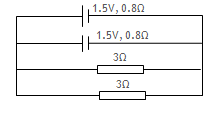
Calculate the current supplied by the cells
c) Describe an experiment which can be carried out to determine the resistance of a wire using a potentiometer
d) A uniform resistance wire AB, 100cm long and of resistance 4.0Ω connected in series with a 2.0Ω resistor to a driver cell of e.m.f 3.4V and negligible internal resistance. Cell X is connected to a 5.0Ω resistor through switch K2. When K1 is closed and K2 is open, the balance length is 53.0cm,
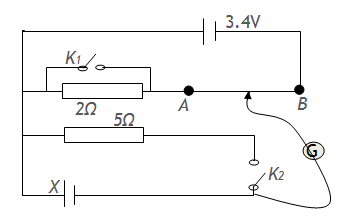
Find the;
i) balance length when K1 and K2 are both open
ii) internal resistance of cell X if the balance length is 44.1cm when both K1 and K2 are closed
10. a) i) Define a Farad
ii) Describe briefly the energy transformations that take place when charging a capacitor using a dry cell.
b) i) What is meant by dielectric constant?
ii) A parallel plate capacitor is charged to 100V and then isolated. When a sheet of a dielectric is inserted between the plates, the p.d decreased to 30V. Calculate the dielectric constant of the dielectric
c) A 60μF capacitor is charged from a 120V supply. It is then connected across the terminals of 20μF capacitor. Calculate the
i) final p.d across the combination
ii) difference in the initial and final energies stored in the capacitors and comment on the difference
d) Explain the principle of operation of a lightning conductor
END
